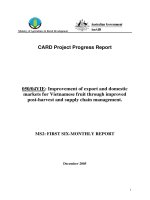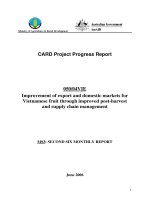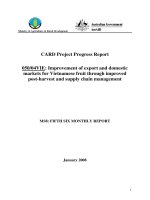Lecture Operations and supply chain management: The Core (3/e) – Chapter 8: Sales and operations planning
Bạn đang xem bản rút gọn của tài liệu. Xem và tải ngay bản đầy đủ của tài liệu tại đây (754.54 KB, 15 trang )
Sales and Operations
Planning
Chapter 08
McGrawHill/Irwin
Copyright © 2013 by The McGrawHill Companies, Inc. All rights reserved.
Learning Objectives
1.
Understand what sales and operations
planning is and how it coordinates
manufacturing, logistics, service, and
marketing plans.
Construct aggregate plans that employ
different strategies for meeting demand.
Describe what yield management is and why
it is an important strategy for leveling
demand.
82
What is Sales and Operations
Planning?
Sales and operations planning is a process that helps
firms provide better customer service, lower inventory,
shorten customer lead times, stabilize production
rates, and give top management a handle on the
business
The process consists of a series of meetings, finishing
with a high-level meeting where key intermediate-term
decisions are made
This must occur at an aggregate level and also at the
detailed individual product level
By aggregate we mean at the level of major groups of
products
83
Sales and Operations Planning
Activities - Overview
84
Types of Planning
85
Aggregate Operations Plans
Specifies the optimal combination of
Production rate (units completed per unit of time)
Workforce level (number of workers needed in a period)
Inventory on hand (inventory carried from previous period)
Product group or broad category (aggregation)
This planning is done over an intermediate-range
planning period of 3 to18 months
Excel: Aggregate Pla
86
Production Planning
Environment
In general, the external environment is outside
the production planner’s direct control
In some firms, demand can be managed
Complementary products work for firms facing
cyclical demand fluctuations
With services, cycles are more often
measured in hours than months
87
Production Planning Strategies
Production planning
strategies are the
plans for meeting
demand. Tradeoffs
involved include
workers employed,
work hours, inventory
and shortages.
A pure strategy uses
just one of these
approaches, a mixed
strategy uses two or
more
88
Relevant Costs
89
Aggregate Planning Techniques
810
Evaluate Alternative Plans
811
Level Scheduling
A level schedule holds production
constant over a period of time
It is something of a combination of the
strategies we have mentioned here
For each period, it keeps the workforce
constant and inventory low, and depends
on demand to pull products through
812
Level Scheduling
Advantag e s
The entire system can be
planned to minimize inventory
and work-in-process
Product modifications are upto-date because of the low
amount of work-in-process
There is a smooth flow
throughout the production
system.
Purchased items from
vendors can be delivered
when needed, often directly
to the production line
Re quire me nts
Production should be repetitive
(assembly-line format)
The system must contain excess
capacity
Output of the system must be fixed
for a period of time
There must be a smooth
relationship among purchasing,
marketing, and production
The cost of carrying inventory must
be high
Equipment costs must be low
The workforce must be multiskilled
813
Yield Management
Yield management - the process of allocating the right
type of capacity to the right type of customer at the
right price and time to maximize revenue or yield
Can be a powerful approach to making demand more
predictable
Has existed as long as there has been limited
capacity for serving customers
Its widespread scientific application began with
American Airlines’ computerized reservation system
(SABRE)
814
Yield Management Success
Factors
815









